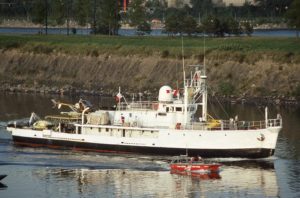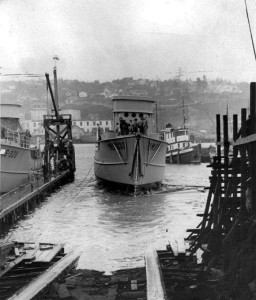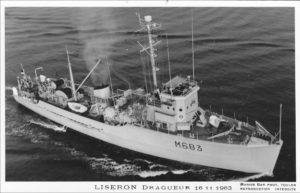Almost every kind of boat imaginable has traveled up and down the Seattle Ship Canal and through the locks over the last 100 years, but few of the thousands of crew or passengers who enjoy that spectacle are aware of another part of local maritime history. It was 75 years ago, when World War II began in Europe, that several of the Seattle shipyards began building small warships to send to Great Britain under the US government’s Lend-Lease program.
I was reminded of this epic time in local boat building history when I wandered into Pacific Fishermen’s yard in Ballard, less than a mile from the office of Northwest Yachting. A very large, fairly old wooden motoryacht was hauled out and stored under a tall portable cover. The M/V Liseron of Juneau was missing lots of deteriorated outer layer of bottom planking, that was piled up to one side of the shelter. This had revealed a second layer of planking underneath that was in much better condition.
I made no attempt to guess at how big this hull was or when it was built. Just as well, because when I found yard manager Doug Dixon, he cheerfully informed me that she was also a converted minesweeper built in 1952. This was a happy coincidence for me and moved the story up to the top of my list. In addition, I quickly realized that Doug is a “mine of information” who has been researching the history of wooden boat building on Lake Union for many years —especially the WW II era.
By then, the yard already had a long history, having been opened in 1874 by a Norwegian named T.W. Lake—over 40 years before the canal and locks were completed. Many of the Mosquito Fleet’s ferries were launched there and departed the lake for Puget Sound during high water. When the yard changed hands, it was re-named Seattle Ship Yards and then Ballard Marine Railway. In 1946 it was bought by a collective of 400 Norwegian fishermen and the name changed again to Pacific Fishermen; interestingly, they ran it as a co-operative for many years.
In 1941, most of the local yards were still building wooden vessels, and after Pearl Harbor, the US Navy needed hundreds of wooden minesweepers. Several Washington yards were selected to build a 136-foot double-planked multi-purpose hull to an original design from the Henry B. Nevins Shipyard of New York City. had a length of 136 feet, beam of 24 feet 6 inches, and draft of 8 feet. The propulsion was two 800 hp General Motors 8-cylinder 268A diesel engines, giving a top speed of 14 knots.
In the three-year period from the spring of 1942 through the spring of 1945, a total of 561 minesweepers were built at 35 small American shipyards, 19 of them on the West Coast. Over 80 were ordered by the government specifically for transfer to Britain, which had been at war with Germany since September 3, 1939, as part of the Lend-Lease policy, signed into law by FDR on March 11, 1941.)
The Ballard Marine Railway built 16 of the basic 278-ton hulls under contract to the Seattle Shipbuilding Company. The inner planking was 2” Douglas fir, the outer layer over 1” thick, to withstand the shock wave when mines were swept up and deliberately detonated by rifle or deck gun. Twelve were fitted out as minesweepers, two as sub-chasers and two as patrol craft during WWII Four of these vessels were commissioned as British Motor Minesweepers (BYMS), and delivered through the Panama Canal across the dangerous North Atlantic to Britain, where they were transferred to the Royal Navy. (Others also went overseas but retained the original Yard Mine Sweeper tag.)
About ten of them appear to have survived the war and went on to various civilian tasks all over the world—the Columbia Bar Pilots used ex-minesweeper YMS 117 as a station boat from 1947 to 1959. But two of the Ballard boats eventually ended up with world- famous owners and became famous in their own right.
BYMS 26–Calypso
BYMS 26 served in the Mediterranean where it was converted into a car ferry. It was discovered by Jacques Cousteau in the 1950s and was converted again into his dive-support ship Calypso. The French diving pioneer and his ship went on to make many discoveries a nd become famous in the USA through the series The Undersea World of Jacques Cousteau, which ran for ten years from 1966 to 1976. At a time when color television was a novelty, his programs opened the eyes of a generation to the wonders beneath the waves. A second documentary series, The Cousteau Odyssey, ran from 1977 to 1982.
nd become famous in the USA through the series The Undersea World of Jacques Cousteau, which ran for ten years from 1966 to 1976. At a time when color television was a novelty, his programs opened the eyes of a generation to the wonders beneath the waves. A second documentary series, The Cousteau Odyssey, ran from 1977 to 1982.
In the later years he became a pioneer in the movement to protect the oceans until a barge accidentally rammed Calypso and sank her in the port of Singapore in 1996. She was raised by a floating crane, patched, and pumped dry before dry docked and repaired. Cousteau died in 1997 in Paris, aged 87. His ship was towed back to France, but fell into neglect as his family quarreled over the future of his foundation. Ambitious plans have been publicized, but the ship is still in very poor shape in storage in Brittany and has been the subject of several legal actions over debts owed for restoration work that was halted when payments failed to materialize.
YMS 328—Wild Goose
YMS 328 was converted into a yacht and in 1956 it was bought by Seattle lumber tycoon Max Wyman, and renamed Wild Goose. Wyman traveled in the South Pacific on the boat until 1962, when it was sold to movie star John Wayne and went through a major renovation. Wayne kept the Wild Goose for the last 17 years of his life and entertained famous people including two presidents– Richard Nixon and Ronald Reagan. He also liked getting away from his busy life at home in California, so he hired a professional crew and had them take the boat and his family to the Pacific Northwest and Alaska in the summer where he joined them and specially enjoyed the fishing and hiking.
Wayne frequented Sequim Bay aboard the Wild Goose and bought a big chunk of land in the area. He envisioned a marina in the scenic bay and The John Wayne Marina (featured in SEA Magazine as “Best of the West” for small marinas), was constructed in 1985 on 22 acres of land donated by the John Wayne family. The Wayne family still owns 150 acres in Sequim, where “John Wayne’s Waterfront Resort,” located steps from the Marina, invites visitors to enjoy getaways or extended stays in cabins or the RV Park. The Wild Goose is now a dinner cruise boat in Newport Beach CA.
MY Liseron
So what about the Liseron? Doug explained that it was a later version of the Navy’s design for the Korean conflict–a 409-ton MSC 90 Mine Sweeper Coastal 60. It is 145 feet long and 28 feet wide with a draft of 8.5 feet; built in 1952 by Tacoma Boat as AMS-98 (Adjutant Class Motor Minesweeper) and later sold to France where it was given the French name Liseron. 
The Boat Company of Poulsbo, Washington had bought its first ex-minesweeper in 1980 and found it to be a fine vessel for eco-cruising and conservation in Alaska’s Inside Passage. They looked for a newer version and acquired the Liseron in 1989. It was lovingly restored and refitted with ten luxurious staterooms that accommodate 20 passengers, with a crew of 12. The company claims to be “the only non-profit educational organization offering luxury eco-cruises through Southeast Alaska.”


